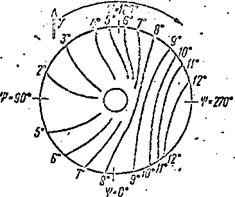Azimuthal Variation of Rotational Resistance Forces and Reactive Torque
Both the rotational resistance forces and the thrust forces of the blades vary azimuthally as a function of the resultant flow velocity over the blades.
|
|
|
|
The resistance to rotation of a single blade reaches its maximal value at the 90° azimuth and minimal value at the 270° azimuth.
At the 0° and 180° azimuths the rotational drag in the forward flight regime is equal to the drag in the axial flow regime, if the main rotor pitch and flight altitude remain the same (Figure 45).
As a result of this variation of the resistance to rotation, there will /61 be azimuthal variation of the main rotor reactive torque from the maximal value when the blades are at the 90° and 270° azimuths to the minimal value when they are located at the 0°and 180° azimuths.
The variation of the reactive torque causes vibration (torsional oscillations) with a frequency equal to the main rotor rpm or some multiple thereof.
For two blades at opposite azimuth angles the rotational resistance forces are directed oppositely relative to the rotor diameter. At the 0° and 180° azimuths their sum is zero; however, at the 90° and 270° azimuths the sum of these forces is not equal to zero and is directed opposite the helicopter
flight direction, since is larger at the 90° azimuth than at the ф = 270° azimuth. This force is the profile drag of the main rotor.













